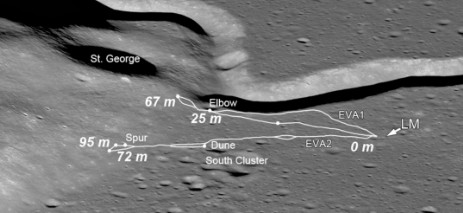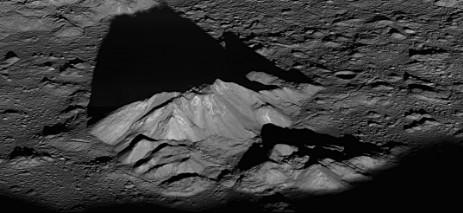Luna
Siti degli allunaggi Apollo
Moon: Apollo Landing Sites
NASA's Lunar Reconnaissance Orbiter, or LRO, has returned its first imagery of the Apollo moon landing sites. The pictures show the Apollo missions' lunar module descent stages sitting on the moon's surface. The satellite reached lunar orbit June 23 and captured the Apollo sites between July 11 and 15. The descent stages sitting was further revisited by LRO's images in subsequent years More info...Programma Apollo
Il programma Apollo fu un programma spaziale americano che portò allo sbarco dei primi uomini sulla Luna. Concepito durante la presidenza di Dwight Eisenhower e condotto dalla NASA, Apollo iniziò veramente dopo che il presidente John Kennedy dichiarò, durante una sessione congiunta al Congresso avvenuta il 25 maggio 1961, obiettivo nazionale il far "atterrare un uomo sulla Luna" entro la fine del decennio.
Questo obiettivo fu raggiunto durante la missione Apollo 11 quando, il 20 luglio 1969, gli astronauti Neil Armstrong e Buzz Aldrin sbarcarono sulla Luna, mentre Michael Collins rimase in orbita lunare. Apollo 11 fu seguita da ulteriori sei missioni, l'ultima nel dicembre 1972, che portarono un totale di dodici uomini a camminare sul nostro "satellite naturale". Al 2016 questi sono stati gli unici uomini a mettere piede su un altro corpo celeste. Per saperne di più...
The Apollo program, also known as Project Apollo, was the third United States human spaceflight program carried out by the National Aeronautics and Space Administration (NASA), which accomplished landing the first humans on the Moon from 1969 to 1972. First conceived during Dwight D. Eisenhower's administration as a three-man spacecraft to follow the one-man Project Mercury which put the first Americans in space, Apollo was later dedicated to President John F. Kennedy's national goal of "landing a man on the Moon and returning him safely to the Earth" by the end of the 1960s, which he proposed in an address to Congress on May 25, 1961.
Kennedy's goal was accomplished on the Apollo 11 mission when astronauts Neil Armstrong and Buzz Aldrin landed their Lunar Module (LM) on July 20, 1969, and walked on the lunar surface, while Michael Collins remained in lunar orbit in the Command/Service Module (CSM), and all three landed safely on Earth on July 24. Five subsequent Apollo missions also landed astronauts on the Moon, the last in December 1972. In these six spaceflights, twelve men walked on the Moon.. More info...
Lunar Reconnaissance Orbiter
Il Lunar Reconnaissance Orbiter (LRO) è un orbiter destinato allo studio della Luna, il cui lancio è avvenuto il 18 giugno 2009 attraverso un vettore Atlas V dalla Air Force Station a Cape Canaveral, in Florida.
È la prima missione ad implementare il piano Vision for Space Exploration e i suoi obiettivi primari saranno di esaminare le risorse lunari e identificare possibili siti di atterraggio per le successive missioni umane di esplorazione. Il 23 giugno, dopo un viaggio di cinque giorni, il Lunar Reconnaissance Orbiter è entrato in orbita attorno alla Luna alle 10:27 UTC. Nei giorni seguenti sono state eseguite manovre per regolarizzare l'orbita. Al 26 giugno l'orbita della sonda risulta essere circolare, caratterizzata da una quota di 200 km dalla superficie lunare. Per saperne di più...
Lunar Reconnaissance Orbiter
The Lunar Reconnaissance Orbiter (LRO) is a NASA robotic spacecraft currently orbiting the Moon in an eccentric polar mapping orbit.
Data collected by LRO has been described as essential for planning NASA's future human and robotic missions to the Moon. Its detailed mapping program is identifying safe landing sites, locating potential resources on the Moon, characterizing the radiation environment, and demonstrating new technologies. On June 23, 2009, the Lunar Reconnaissance Orbiter entered into orbit around the Moon after a four-and-a-half-day journey from the Earth. When launched, the spacecraft was aimed at a point ahead of the Moon's position. A mid-course correction was required during the trip in order for the spacecraft to correctly enter Lunar orbit. More info...
LRO:This LRO image shows the area surrounding Apollo 15's landing site, annotated with the traverse plots of the mission's first two moonwalks.Crediti: NASA
LRO: In honor of the fifth anniversary of the Lunar Reconnaissance Orbiter (LRO), the public selected this image of Tycho Central Peak as its favorite moon image. Image Credit: NASA
Sistema Solare Interno Mercurio Venere Terra | Sistema Solare Esterno | Via Lattea | Universo Supernova Extragalattiche |
Prenota la mostra per i tuoi eventi (da novembre 2017) | |||






































